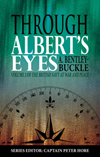
By Tony Bentley-Buckle
Edited by Captain Peter Hore RN
Whittles Publishing, Caithness, 2013
www.whittlespublishing.com
Hardback; 143 pages with 44 b/w illustrations and end notes.
ISBN 978-184995-066-4
Reviewed by David Hobbs
THIS IS the second in a series of autobiographical books, edited by Peter Hore, that focus on people connected with naval warfare and the sea. Tony Bentley-Buckle led a particularly adventurous life; he was the son of a rubber planter in Ceylon, born in Belgium while his parents were on holiday and subsequently raised in England by aunts before joining the Royal Navy as a cadet in 1938. In the early war years he served in the cruisers Dunedin and Edinburgh before joining the battleship Revenge in the Eastern Fleet during 1941.
Whilst on leave, staying with friends near Mombasa, he broke an arm badly riding and during his convalescence he volunteered for special service. After training in Scotland he joined the Royal Navy’s ‘G’ Commando as a Beachmaster during 1943, becoming one of the first allied officers ashore in both Sicily and at Reggio on the Italian mainland. At the latter he achieved some notoriety when General Montgomery started to address troops on a narrow trackway off the beach and Buckle ordered him to clear the landing area so that vital supplies could be moved towards men in action who needed them. The General and his audience moved.
Subsequently Buckle took part in operations with Yugoslav partisans during which he was captured, escaped, betrayed and captured again, together with the war artist John Worsley. Together they ended up in Marlag O prisoner of war camp where he helped Worsley to build a ‘dummy prisoner’ which subsequently became famous as ‘Albert RN’. Buckle repaired watches as a hobby and his input was to make a clockwork system inside the papier-mâché head that made the eyelids appear to blink; the eyeballs themselves were made from table-tennis balls. The dummy was dismantled and hidden in towels when prisoners marched out to a bath-house outside the wire, then assembled and ‘marched in’ to cover the absence of a single prisoner who escaped once the bath-house was vacated. Unfortunately Buckle himself was not able to escape before the Germans spotted the ruse.
After the war Worsley made a replica ‘Albert’ for the British film ‘Albert RN’ in 1953 and a second, without the blinking mechanism, which is now on display in the National Museum of the Royal Navy.
Post-war Buckle made his own way back to the UK before the official repatriation scheme got under way and underwent training to become a pilot in the Fleet Air Arm but, like many other former prisoners, could not settle back into the peace-time Navy and resigned. He subsequently bought a small coaster and began what proved to be a very successful shipping business in East Africa, despite bitter opposition from larger, more well-established concerns that tried to prevent him from breaking their monopoly.
This is a well-written and fascinating story and the descriptions of amphibious and asymmetric warfare have topical value in Australia as the RAN begins to establish its own ‘beachhead commando’ equivalents. Buckle was clearly a resourceful and determined man in both his naval and civilian careers; his story is an interesting one and it is enhanced by a number of John Worsley’s wartime sketches. It is a good read and I thoroughly recommend it.



